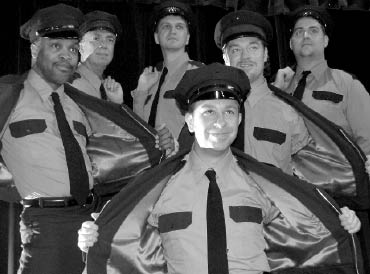Going Full Monty at Artpark
by Anthony Chase

Buffalo has been featured in a number of Broadway musicals. In 42nd Street, half the cast shuffles off to it. Mame laments, “How bleak was my puberty in Buffalo!” In A Chorus Line, we are advised that “Suicide in Buffalo is redundant.” In Gypsy, Tulsa tells Louise “All I Need Is the Girl,” in the alley of the Lafayette Theatre in Buffalo, New York.
But in terms of being a major Broadway musical with a 100 percent Buffalo setting, The Full Monty stands alone. The show will be performed at Artpark now through August 20 in a production directed and choreographed by Lynne Kurdziel-Formato.
The Full Monty began life in 1997 as a film about unemployed steelworkers in Sheffield, England who decide to put on a Chippendales-style strip show in a desperate effort to earn some cash. When word began to circulate that a musical stage version would be making its debut at San Diego’s Old Globe Theatre in the summer of 2000, I did not hesitate. I flew to San Diego.
Terrence McNally, who had previously written the books for such musicals as Ragtime, The Rink and The Kiss of the Spider Woman, felt that the Buffalo location would make the story more accessible to American audiences. At the time, he ruffled the feathers of Buffalo Congressman Jack Quinn, who, without ever having seen the show or a script, complained by letter that “Your current treatment of our city is both incorrect and irresponsible,” adding, “As you may be aware, the City of Buffalo is following in the footsteps of other cities like Baltimore, Md., and Cleveland, Ohio, in developing a prosperous waterfront facility.”
I think it is probably safe to say that the lack of development on our waterfront, even now, six years later, is not due to the damaging impact of The Full Monty. In fact, the show presents Buffalonians in a very positive light, as upbeat, resilient, loyal and supportive of their neighbors. It also helped that the original cast was remarkable, including Kathleen Freeman in the final performance of her career; Broadway diva Emily Skinner; and André De Shields, original star of The Wiz and Ain’t Misbehavin’. De Shields has a substantial Buffalo pedigree of his own—indeed, he now holds an Honorary Doctorate of Fine Arts from Buffalo State College.
The show was clearly a winner. With an appealing score by David Yazbek, direction by Jack O’Brien and choreography by Jerry Mitchell, the story clicked along happily and was populated by engaging and likeable characters who squabbled through the problems caused by being short on cash, but who triumphed in the end.
The Buffalonian in me was disappointed that our city is really the setting of the story in name only. The Full Monty actually takes place in a Rust Belt Neverland that bears only a passing acquaintance with the Queen City of the Great Lakes. McNally makes use of fictional geography and community dynamics. I felt that greater specificity would have enriched the musical, which, unlike its cinematic predecessor, floats in a fairytale realm.
After the show, we visited with Andre De Shields and congratulated him on his performance as Noah “Horse” T. Simmons, a turn that certainly would have earned him a Tony Award, had The Producers not opened in the same season. Then, as Javier and I were walking to the mostly empty parking lot in Balboa Park, we realized that the only other people still in the park, walking down the steps beside us, were Terrence McNally, the show’s star Jason Danieley and Mr. Danieley’s wife, Marin Mazzie, who was, at the time, starring in Kiss Me Kate on Broadway.
This little trio of Broadway royalty did not expect to be recognized in Balboa Park, San Diego, and were surprised when Javier hailed Miss Mazzie with the greeting, “Aren’t you supposed to be on Broadway?”
She shushed him with a laugh and said, “My understudy went on tonight. It was my only chance to see my husband in his show!”
We explained that we had enjoyed the show, which gratified them. But when we explained that we had come in from Buffalo, they were fascinated. We stood in the middle of the empty parking lot for the next 20 minutes answering questions about Buffalo.
McNally was clearly stung by Congressman Quinn’s attack, which he felt was entirely unjustified and based on ignorant assumptions. Mazzie observed that the New York Times had featured an article about Buffalo as an economically troubled area during the previous week. We talked about the closing of Bethlehem Steel. We talked about the closing of Berger’s department store and the end of downtown shopping. We told McNally that Wilson Farms was more specific to Buffalo than Seven Eleven (a change he did not make) and we assured him that Buffalonians would love The Full Monty.
Buffalonians have loved The Full Monty, which toured successfully to Shea’s in 2002. They are likely to love the show again at Artpark where the production has the distinction of being entirely locally produced. In addition to benefiting from the genius of Kurdziel-Formato and the expert and lively musical direction of Michael Hake, the show stars some of Buffalo’s best-loved musical theater performers: Lou Colaiacovo, Tom Owen, Bobby Cooke, Lisa Ludwig, Loraine O’Donnell Gray, Ann Mosner and Doug Weyand—Artie Award winners all. At a time when musical revues seem to be overtaking fully produced book musicals, a large-scale production of a show like The Full Monty with a first-rate cast is a very welcome arrival.
|
Issue Navigation> Issue Index > v5n32: Byron Brown on the Casino Deal (8/10/06) > Going Full Monty at Artpark This Week's Issue • Artvoice Daily • Artvoice TV • Events Calendar • Classifieds |









 Current Issue
Current Issue